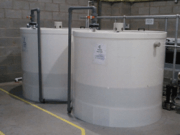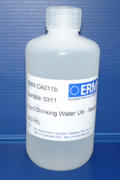Certified reference materials
Certified Reference Materials (CRMs) are ‘controls’ or standards used to check the quality and metrological traceability of products, to validate analytical measurement methods, or for the calibration of instruments.[1] A certified reference material is a particular form of measurement standard.
Reference materials are particularly important for analytical chemistry and clinical analysis.[2] Since most analytical instrumentation is comparative, it requires a sample of known composition (reference material) for accurate calibration. These reference materials are produced under stringent manufacturing procedures and differ from laboratory reagents in their certification and the traceability of the data provided.
Quality management systems involving laboratory accreditation under national and international accreditation/certification standards such as ISO/IEC 17025 require metrological traceability to Certified Reference Materials (where possible) when using reference materials for calibration.[3]
Whilst Certified Reference Materials are preferred where available,[3][4] their availability is limited. Reference Materials that do not meet all the criteria for certified reference materials are more widely available: the principal difference is the additional evidence of metrological traceability and statement of measurement uncertainty provided on the certificate for certified reference materials.[5]
Terminology
ISO REMCO definitions
ISO REMCO, the ISO committee responsible for guidance on reference materials within ISO,[6] defines the following classes of reference material:[7][8]
- Reference Material
- Material, sufficiently homogeneous and stable with respect to one or more specified properties, which has been established to be fit for its intended use in a measurement process.
- Certified Reference Material
- Reference material characterized by a metrologically valid procedure for one or more specified properties, accompanied by a certificate that provides the value of the specified property, its associated uncertainty, and a statement of metrological traceability.
Alternative terminology
Other bodies may define classes of reference material differently. WHO guidelines for biological[nb 1] reference materials [9] provide the terms:[nb 2]
- Reference standards: materials that are used as calibrators in assays
- International biological measurement standard: a biological substance provided to enable the results of biological assay or immunological assay procedures to be expressed in the same way throughout the world
- Secondary reference standards: Reference standards calibrated against and traceable to primary WHO materials and intended for use in routine tests
- Reference reagent: a WHO reference standard, the activity of which is defined by WHO in terms of a unit
For chemical substances some pharmacopoeias[10] use the WHO terms[11]
- Primary chemical reference substance: a chemical reference substance ... whose value is accepted without requiring comparison to another chemical substance.
- Secondary chemical reference substance: substance whose characteristics are assigned and/or calibrated by comparison with a primary chemical reference substance.
The United States National Institute of Standards and Technology (NIST) uses the trade marked term[12] Standard Reference Material (SRM) to denote a certified reference material that satisfies additional NIST-specific criteria. In addition, commercial producers adhering to criteria and protocols defined by NIST may use the trademark [13] "NIST traceable reference material" to designate certified reference materials with a well-defined traceability linkage to existing NIST standards for chemical measurements. [14][15] The term European reference material (ERM) is, similarly, a trademarked[16] term referring to CRMs produced by the European Reference Materials consortium.
Types of reference material
ILAC describes the following five types of reference material:[1]
- Pure substances; essentially pure chemicals, characterised for chemical purity and/or trace impurities.
- Standard solutions and gas mixtures, often prepared gravimetrically from pure substances.
- Matrix reference materials, characterised for the composition of specified major, minor or trace chemical constituents. Such materials may be prepared from matrices containing the components of interest, or by preparing synthetic mixtures.
- Physico-chemical reference materials, characterised for properties such as melting point, viscosity, or optical density.
- Reference objects or artefacts, characterised for functional properties such as taste, odour, octane number, flash point and hardness. This type also includes microscopy specimens characterised for properties ranging from fibre type to microbiological specimens.
Production
Principal steps in producing certified reference materials
The preparation of certified reference materials is described in general in ISO Guide 34[17] and in more detail in ISO Guide 35.[18] Preparation of biological reference standards is described in WHO Guidance.[9] General steps required in production of a certified reference material typically include:[18]
- Collection or synthesis of material
- Sample preparation (including homogenization, stabilization, bottling etc.)
- Homogeneity testing
- Stability assessment
- Value assignment ("characterization" in ISO REMCO terms).[19]
In addition it may be important to assess the commutability of a reference material; this is especially important for biological materials.[9]
Sample preparation
Detailed sample preparation depends on the type of material. Pure standards are most likely to be prepared by chemical synthesis and purification and characterized by determination of remaining impurities.[1] This is often done by commercial producers. Natural matrix CRMs (often shortened to 'matrix CRMs') contain an analyte or analytes in a natural sample (for, example, lead in fish tissue). These are typically produced by homogenization of a naturally occurring material followed by measurement of each analyte. Due to the difficulty in production and value assignment, these are usually produced by national or transnational metrology institutes like NIST (USA), BAM (Germany), KRISS (Korea) and IRMM (Joint Research Centre European Commission).
For natural materials, homogenization is often critical;[20] natural materials are rarely homogeneous on the scale of grams so production of a solid natural matrix reference material typically involves processing to a fine powder or paste.[21] Homogenization can have adverse effects, for example on proteins, so producers must take care not to over-process materials.[9][18] Stability of a certified reference material is also important, so a range of strategies may be used to prepare a reference material that is more stable than the natural material it is prepared from.[22]:119–124 For example, stabilizing agents such as antioxidants or antimicrobial agents may be added to prevent degradation, liquids containing certified concentrations of trace metals may have pH adjusted to keep metals in solution, and clinical reference materials may be freeze-dried for long term storage if they can be reconstituted successfully.[9]:96
| Three steps in producing a natural water CRM | ||||||
|---|---|---|---|---|---|---|
|
Homogeneity testing
Homogeneity testing for a candidate reference material typically involves replicated measurements on multiple units or subsamples of the material.
Homogeneity tests for CRMs follow planned experimental designs. Because the experiment is intended to test for (or estimate the size of) variation in value between different CRM units, the designs are chosen to allow separation of variation in results due to random measurement error and variation due to differences between units of the CRM. Among the simplest designs recommended for this purpose is a simple balanced nested design (see schematic).

Typically 10-30 CRM units are taken from the batch at random; stratified random sampling is recommended so that the selected units are spread across the batch.[23] An equal number of subsamples (usually two or three) is then taken from each CRM unit and measured. Subsamples are measured in random order.[23][18] Other designs, such as randomized block designs, have also been used for CRM certification.
Data processing for homogeneity tests usually involves a statistical significance test for evidence of differences between units of the candidate CRM. For the simple balanced design above, this typically uses an F test following ANOVA. A check for trends with production order is also recommended.[23] Where there is evidence of inhomogeneity, the homogeneity study data are used to estimate the size of the dispersion in certified value from one unit to another; this is the 'between-unit' or 'between-bottle' variance. This may then be used as a part of the uncertainty in the certified value.[23] In ISO Guide 35:2006, an allowance for undetected between-unit variation is suggested regardless of the result of the significance test.[18]
In extreme cases, such as microanalysis, materials must be checked for homogeneity on sub-micron scales; this may involve much larger numbers of observations and adjustments to statistical analysis.[24]
See also
- ISO Guide 32: 1997 - Calibration in analytical chemistry and use of certified reference materials
- ISO Guide 33: 2000 - Uses of certified reference materials
- European Reference Materials
- Canadian Reference Materials
- GeoReM (Geological and Environmental Reference Materials) Database - http://georem.mpch-mainz.gwdg.de/
References
- ↑ 1.0 1.1 1.2 "ILAC G9:2005 - Guidelines for the Selection and Use of Reference Materials". 2005. Retrieved 30 May 2013.
- ↑ Calli, J. Paul (1979). "The role of reference materials in the analytical laboratory". Fresenius' Zeitschrift für analytische Chemie 297 (1): 1–3. doi:10.1007/BF00487739. ISSN 1618-2650.
- ↑ 3.0 3.1 "ILAC-P10:01/2013 - ILAC Policy on the Traceability of Measurement Results". International Laboratory Accreditation Cooperation. 2013. pp. 8–9. Retrieved 1 June 2014.
- ↑ Ellison, Stephen L R; King, Bernard; Roesslein, Matthias; Salit, Marc; Williams, Alex, eds. (2003). "Traceability in Chemical Measurement". http://www.eurachem.org''. Eurachem. pp. 21–22. Retrieved 1 June 2014.
- ↑ ISO Guide 31:2000 - Contents of certificates & labels of reference materials. Geneva: International Organization for Standardization. 2000.
- ↑ "ISO/REMCO Committee on reference materials". International Organization for Standardization. Retrieved 1 June 2014.
- ↑ ISO Guide 30:1992/Amd1 - Revision of definitions for reference material and certified reference material. Geneva: International Organization for Standardization. 2008.
- ↑ "Definitions". http://www.nist.gov''. National Institute of Standards and Technology. Retrieved 1 June 2014.
- ↑ 9.0 9.1 9.2 9.3 9.4 9.5 WHO Expert Committee on Biological Standardization (2004). "Annex 2: Recommendations for the preparation, characterization and establishment of international and other biological reference standards". WHO Expert Committee on Biological Standardization: Fifty-fifth report. Geneva: World Health Organization. ISBN 92 4 120932 1.
- ↑ "Reference standards". British Pharmacopoiea. Retrieved 1 June 2014.
- ↑ "Reference Substances and Infrared Reference Spectra for Pharmacopoeial Analysis: Introduction". Retrieved 1 June 2014.
- ↑ [http://tarr.uspto.gov/servlet/tarr?regser=serial&entry=74287627 Standard reference material ]
- ↑ [http://tarr.uspto.gov/servlet/tarr?regser=serial&entry=75939575 NTRM]
- ↑ "SRM definitions". http://www.nist.gov''. National Institute of Standards and Technology. Retrieved 3 June 2014.
- ↑ May, W.; Parris, R.; Beck, J. Fassett; Greenberg, R.; Guenther, F.; Kramer, G.; Wise, S.; Gills, T.; Colbert, J.; Gettings, R.; MacDonald, B. (January 2000). "NIST Special Publication 260-136: Definitions of Terms and Modes Used at NIST for Value-Assignment of Reference Materials for Chemical Measurements". Natl. Inst. Stand. Technol. Spec. Publ. 260-136. Retrieved 3 June 2014.
- ↑ [http://tarr.uspto.gov/servlet/tarr?regser=serial&entry=75939575 ERM European Reference Materials]
- ↑ ISO Guide 34:2009 - General requirements for the competence of reference material producers. Geneva: International Organization for Standardization. 2009.
- ↑ 18.0 18.1 18.2 18.3 18.4 ISO Guide 35:2006 - Reference materials - General and statistical principles for certification. Geneva: International Organization for Standardization. 2006.
- ↑ ISO Guide 30:1992 - Terms and definitions used in connection with reference materials. Geneva: International Organization for Standardization. 1992.
- ↑ Linsinger, Thomas P J; Pauwels, Jean; van der Veen, Adriaan M H; Schimmel, Heinz; Lamberty, Andre (January 2001). "Homogeneity and stability of reference materials". Accreditation and Quality Assurance (Springer-Verlag) 6 (1): 20–25. doi:10.1007/s007690000261. ISSN 1432-0517.
- ↑ "Guidelines for the production of BAM reference materials (Version 1, June 2006 Updated April 2010)". http://www.bam.de''. Bundesanstalt für Materialforschung und -prüfung. 20 June 2006. pp. 7–8. Retrieved 13 June 2014.
- ↑ Quevauviller, Ph.; Maier, E.A. (1999). Interlaboratory studies and certified reference materials for environmental analysis the BCR approach. Amsterdam: Elsevier. ISBN 0444823891.
- ↑ 23.0 23.1 23.2 23.3 Schiller, Susan B (July 1996). "NIST Special Publication 260-125. Standard Reference Materials: Statistical aspects of the certification of chemical batch SRMs". Natl. Inst. Stand. Technol. Spec. Publ. (National Institute of Standards and Technology). 260-125. Retrieved 25 July 2014.
- ↑ Mattiuzzi, Marco; Markowitz, Andrej. "A Modified Approach to Homogeneity Testing at Microscale". http://www.icdd.com''. International Centre for Diffraction Data. Retrieved 1 July 2014.


